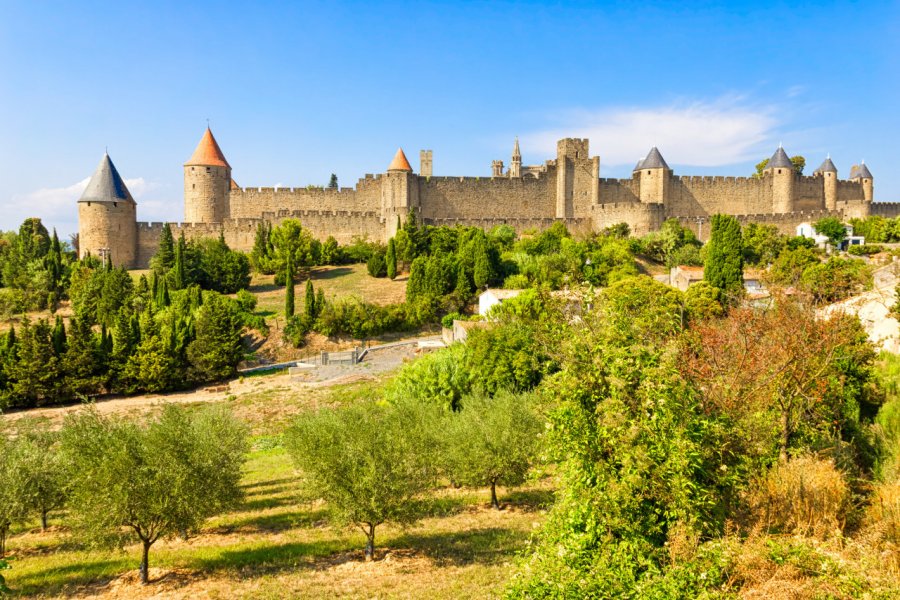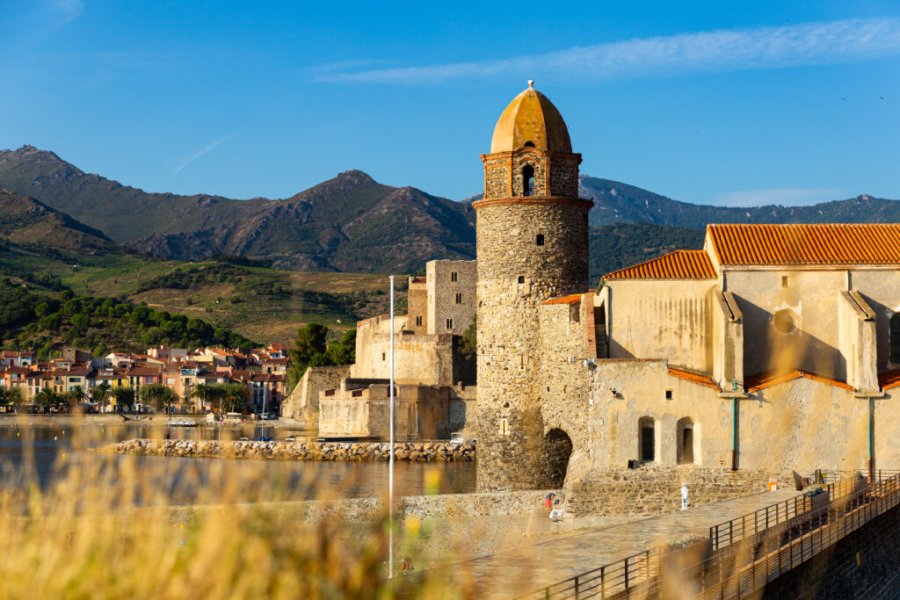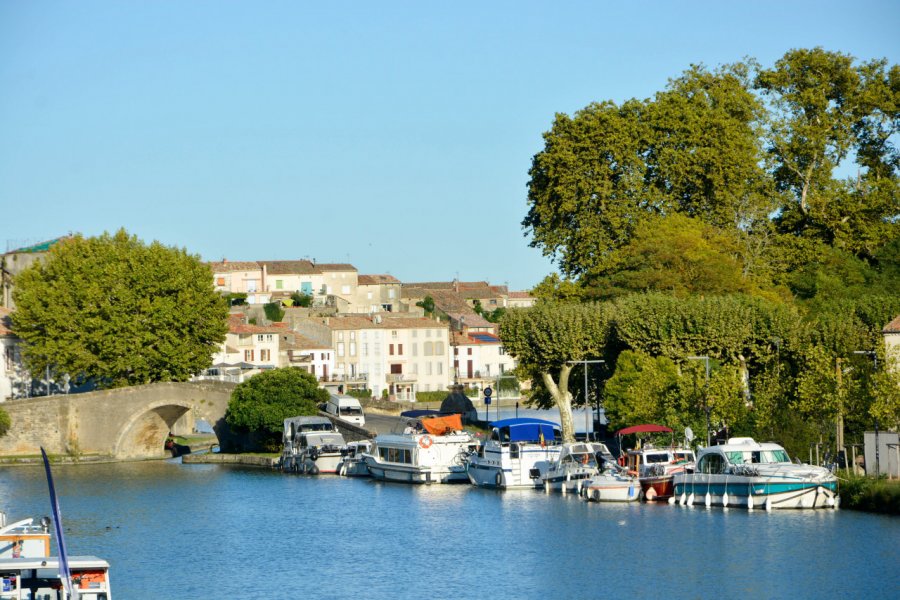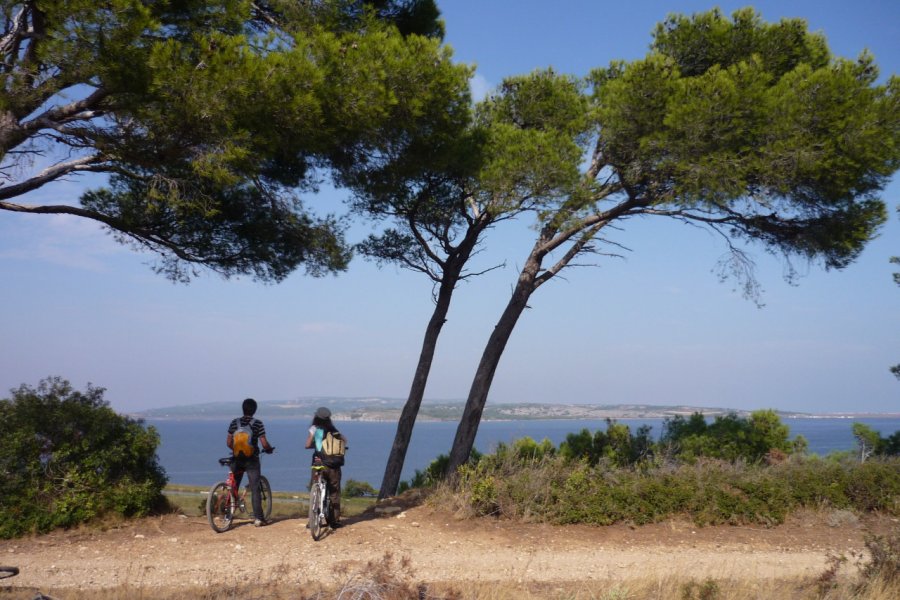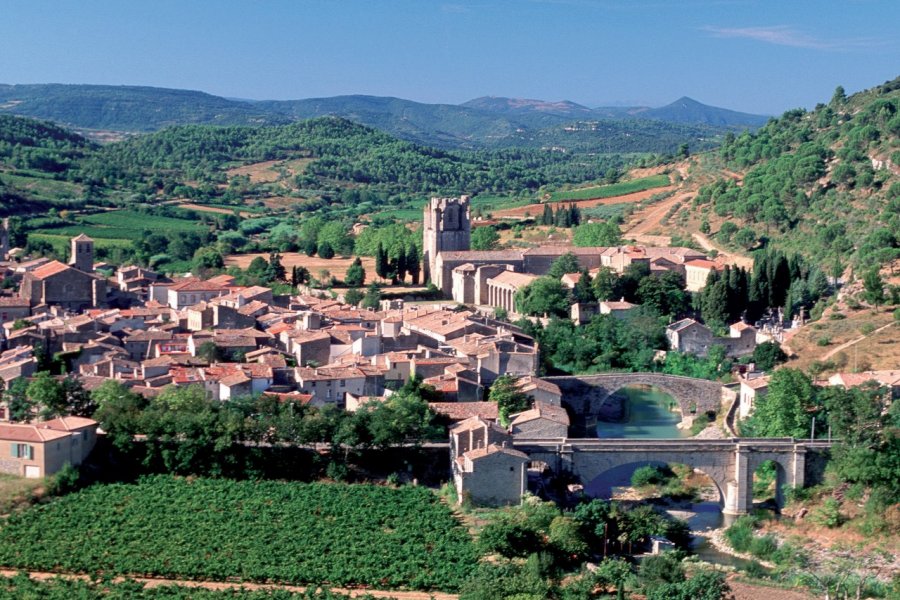Travel guide Aude
This agricultural department and labelled Cathar Country multiplies the attractions, the sea and the greenery, the Canal du Midi and the medieval fortified city of Carcassone, Narbonne and Castelnaudary, without forgetting the gastronomy of the Southwest. Go on the cassoulet route and the Aude wine route (Corbières, Minervois, Blanquette de Limoux...), seafood and local produce. Enjoy oysters and eels, beef from the Pyrenees, capon, pork and lamb from the Cathar country, fattened duck and beans from Castelnaudary, rice from the pond of Marseillette, sheep and goat cheeses, potatoes from the Sault region... And above all, take the time. For example, by discovering the Aude river from the Canal du Midi and the Robine. You will also enjoy the coastline, within the Narbonnaise Regional Natural Park in the Mediterranean, with the Corbières maritimes and its lagoons with pink flamingos and white stilts. Added to this is the picturesque Port-la-Nouvelle and Gruissan, the fishing ports.
In fact, each natural region of the Aude, and there are many of them, is marked by a particular landscape. In the lands, the scrubland and scrubland dominate the landscape of the dry areas of the Corbières. The Sault region is covered with beech and fir forests on the mountain floor. To the northwest, it is the Montagne Noire, land of the sheep. In the Lauragais, the cereal grove draws the hills. Finally and of course, in the heritage of the Aude, there are the castles and other Cathar sites, abbeys and villages of character.
What to see, what to do Aude?
-
Book an activity
-
Customized travel
- The most beautiful cities Aude
When to go Aude ?
TheAude is a tourist department with a rich historical and cultural heritage and a wide variety of natural sites. Tourism is favored by a large number of hotels of all categories, available all year round. The variety of biotopes added to the richness of the built heritage allows for tourism in all four seasons and for all tastes. In summer, the seaside resort of Port-Leucate is packed. Windy, it is appreciated by surfers. You can also swim at Narbonne Plage and Gruissan Plage, but also in the numerous lakes and rivers of the department. The coastline also offers - but to be avoided in the summer when it is very hot to walk and naturalist observations are less interesting - the protected site of the Corbières maritimes and the lagoons crisscrossed by nearly 200 km of paths divided into 30 loops, 10 heritage circuits, as well as 2 GR linking the villages. In the off-seasons the climate remains mild and there are fewer tourists.
Throughout the year, the Aude region offers cultural and festive events. The carnival of Limoux, one of the longest in the world. It takes place every weekend from mid-January to the end of March, animated by bands in Pierrot costumes (the fécos) accompanied by musicians. In the Limoux region, the Sieur d'Arques winegrowers organize Toques et clochers, their gastronomy festival, on Palm Sunday weekend. Narbonne and Carcassonne come alive with numerous shows throughout the summer. The Saint-Pierre (June 29), the fishermen's festival, is very lively in Leucate and Gruissan. In the latter town, the Saint-Pierre is accompanied by a pilgrimage to Notre-Dame des Auzils. Another pilgrimage is to Notre-Dame de Marceille (early October), in honor of the Virgin of Sunday. Very specialized, the festival Voix d'étoiles in Port-Leucate, international festival of the voices of the animation cinema, takes place at the end of October.
Suggested addresses Aude
Travel Aude
-
Find a hotel
-
Car Rental
-
Find a local agency
Find unique Stay Offers with our Partners
Discover the bike tours Aude
Featured articles Aude
Events
Discover Aude
Immersing yourself in this department means soaking up its history. It's going back to Roman times, when Narbo Martius was the "eldest daughter of Rome", and it's coming into contact with the long medieval period. The city of Carcassonne, the Cathar castles and abbeys bear witness to this fabulous thousand-year-old era. Whether hiking or lounging under a parasol, from the coast to the Lauragais, from the Minervois to the Pyrenean foothills, visitors will always receive warmth and courtesy. This savoir-vivre is also reflected in the region's ancestral gastronomy, with its surprising and specifically local ingredients, both on the coast and in the hinterland. Along the Canal du Midi, the vineyards will beckon you to sample the nectars produced by winegrowers who love their land. They too are part of a heritage rich in diversity, jealously preserved to ensure its longevity. The Aude has a thousand riches to delight you.
Pictures and images Aude
The 12 keywords Aude
1. BLANQUETTE DE LIMOUX
The manuscripts of the Benedictine monks of the Abbey of St-Hilaire, near Limoux, dating back to 1531 mention the production of a sparkling wine. This is how Blanquette de Limoux became the oldest sparkling wine in the world. The name blanquette comes from the white coloring under the leaves of the Mauzac grape variety which is its main ingredient.
2. # CARNIVAL

Limoux has the longest carnival in the world, which takes place every Saturday and Sunday from January to April. Precise rules apply to the day's three carnival outings. The night of the Blanquette crowns the end of the festivities. On that night, the main float and its effigy of the carnival king are burn in the public square in popular jubilation.
3. # CASSOULET
A very codified local dish, with white beans in sauce and meat, is the pride of the people of Audois, whose origins date back to the 100 Years' War. Legend has it that during a siege of Castelnaudary by the English, the inhabitants, threatened by famine, cooked everything they had to feed the soldiers, which led to the birth of this dish.
4. # CATHAR CASTLES
Among the many castles of the Cathar country, the citadels were built in the 12th century ans still stand proudly as sentinels. These fortified sites, also called "eagle's nests", dominating the valleys on steep promontories, were ideal lookout posts. They were mainly used to defend the southern border against the crown of Aragon.
5. # FESTIVALS
The Aude is full of festivals of all kinds, which take place throughout the year. Whether it is musical, cinematographic, theatrical, oenological, gastronomic, historical, heritage or even sporting... The field of proposals is so eclectic and complete you will inevitably find a favorite among the mosaic of themes highlighted.
6. # OSTREICULTURE

In the heart of a preserved nature between pond and sea, you can taste the seafood, shellfish, mussels and oysters of the producers from Leucate and Gruissan. Conviviality is the key word, while tasting the products of the oyster farms of the Aude region, including the "Caramoun", a special oyster from the oyster farmers of Leucate, with its rich flesh and exquisite taste.
7. # ROMANITY
Narbo Martius, the original name of Narbonne, was founded in 118 BC. At first, it was an important trading port with an oppidum (fortified settlement) on the Via Domitia, which grew from a simple Roman colony to the capital of a territory extending from Geneva to Toulouse. The city keeps trace of many Roman vestiges.
8. # RUGBY
Rugbyis sacred in the Aude ! Born in the aristocratic milieu, it gradually spread to all social classes, until it became an anchor of identity. In this department, a "fratricidal war" took place between the supporters of XV rugby and those of the XIII game, which was more present in the western half of the department.
9. # SUN
Bathed in sunshine, the Aude is particularly prized for its climate and its sunlight. With 300 days of sunshine per year, the sun plays an important role in the quality of grapes production and the famous wine that comes from it. It enhances the landscapes of the Aude, and provides delicious and warm days perfect for swimming!
10. # UNESCO

Rich of its history and its heritage, the Aude owns 2 sites classified as world heritage by UNESCO: the city of Carcassonne and the Canal du Midi. Nowadays, the series of Citadels of Vertigo (Lastours, Termes, Aguilar, Quéribus, Peyrepertuse, Puilaurens and Montségur), built in the 13th century, is a candidate for a 3rd classification.
11. # WIND

Eole, master of the wind in Greek mythology, can sometimes blow so hard on this territory, that the inhabitants of a neighbouring department have given the Audois the nickname of "Flat Head". The wind on the coastal part can reach 120 km/h and this, up to 270 days/year, be it the Cers, land wind, the Marin, sea wind, or episodically the Greek.
12. # VINEYARDS
The vine that shapes the Aude landscape was introduced by the Romans into the department in the 2nd century BC. Nowadays, and for the past 3 centuries, it has been the main local economic resource. With its 9 protected designations of origin (AOC), the quality of Aude wines is unanimously acclaimed, and they have become key players on the market.
You are from here, if...
You are called "Gabatch" by a Catalan, "Flat Head" by a Héraultais.
You punctuate your sentences with an Occitan word such as "Magnac" or "Macarel", and replace the words "stick" by "peguer", and "kiss" by "poutou".
For you, a chocolate croissant is nothing but a "chocolatine" and when you clean the floors you don't use a mop, but a "peille".
You consider all departments beyond Occitania to be the North Pole!
You were raised on duck confit, cassoulet from Castelnaudary and the wines of the 10 Aude designations.
The only bubbles you know since your childhood are not those of an American brown soda, but the emanations of the Blanquette de Limoux.
You want to explain to the TV weathermen that you don't live in the South-West or the South-East, but simply in the South, with the Paris meridian passing right through the center of Carcassonne!
Other destinations Aude
- Carcassonne
- Narbonne
- Lagrasse
- Gruissan
- Termes
- Montolieu
- Leucate-Plage
- Lastours
- Caunes-Minervois
- Saint-Hilaire
- Alet-Les-Bains
- Cabrespine
- Port-La Nouvelle
- Port Leucate
- Labastide-D'Anjou
- Pradelles-En-Val
- Axat
- Aragon
- Rieux-Minervois
- Montréal
- Fanjeaux
- Castans
- Saissac
- Villeneuve-Minervois
- Fitou
- Pennautier
- Leucate
- Pradelles-Cabardès
- Castelnaudary
- Chalabre

